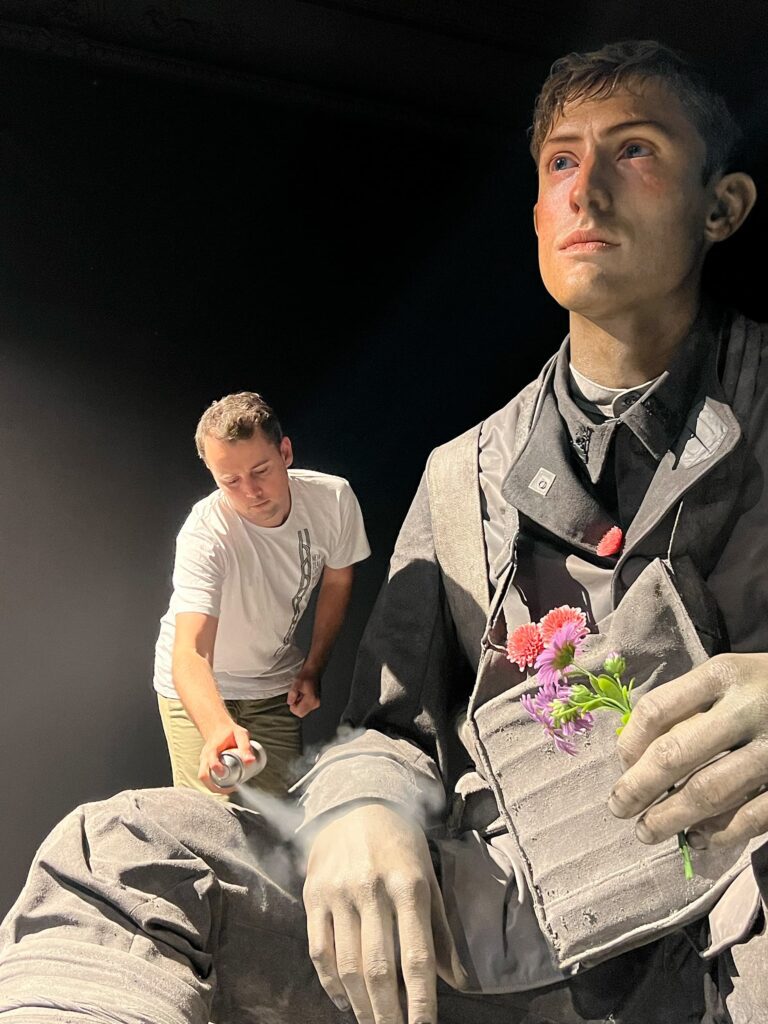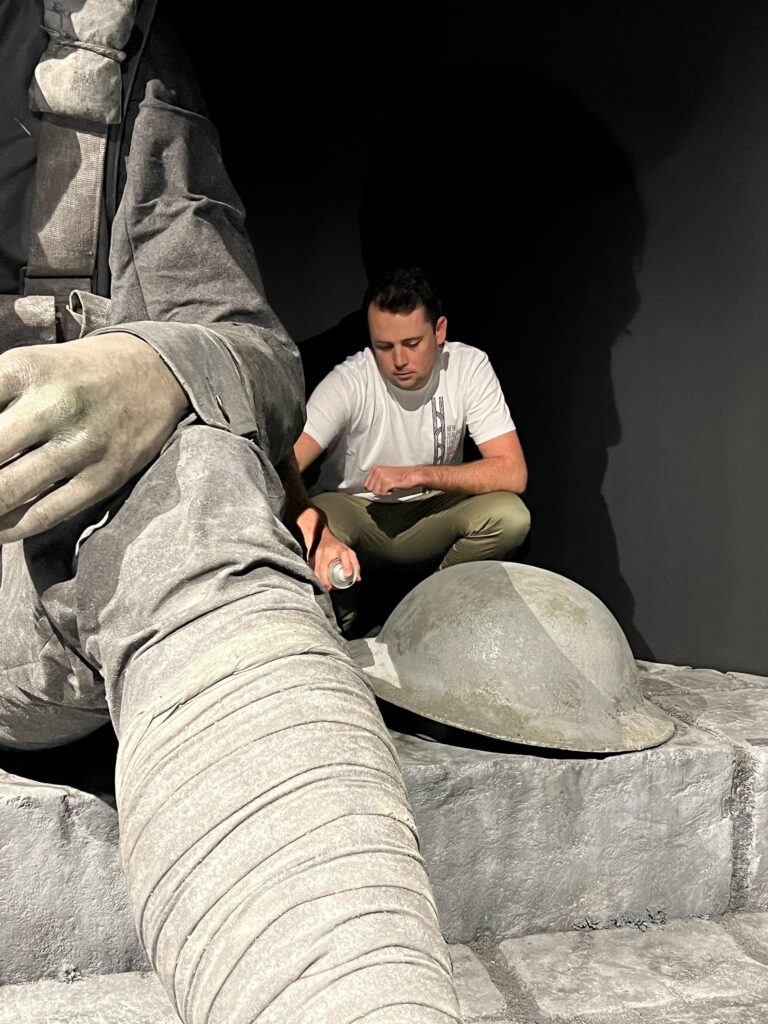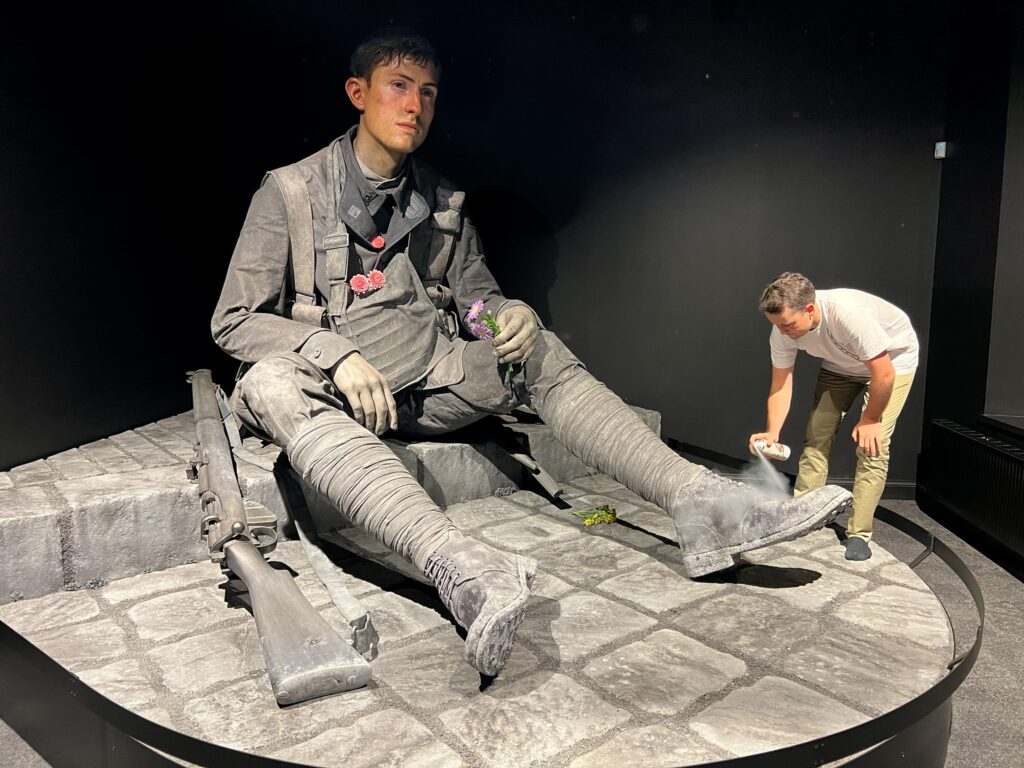Cleaning regime key to creating a unique visitor experience
It takes more than a feather duster, vacuum cleaner and mop to clean the New Zealand Liberation Museum – Te Arawhata.
A compressed air canister is used to clean dust off the large-scale, hyper-realistic soldier which is one of the first figures visitors see when they enter the museum in Le Quesnoy.
“Extra care is needed when cleaning the soldier to ensure we preserve its diverse materials and textured surfaces” says Museum Director, Lizzie Wratislav.
The museum team clean and conduct exhibit maintenance at Te Arawhata every four to eight weeks, or more frequently if required.
“Compressed air helps to remove dust from the soldier and ensure the realistic hair remains intact. Despite how it might look, it’s not spray paint!
“The team carefully stand on the plinth without shoes to ensure the surfaces are not damaged, and to get close enough to reach the heights of the larger-than-life soldier,” says Wratislav.
The sculpture, created by Wētā Workshop, depicts a New Zealand Rifle Brigade soldier captured in a moment of reflection following the liberation. He is resting on a cobblestone footpath, his rifle placed gently by his side.
Richard Taylor, Wētā Workshop CEO and Creative Director, says, “Playing with scale allows visitors to get up close to the hyper-realistic soldier, placing them in that significant moment which took place over 100 years ago.”
Historical quotes projected on the wall beside the soldier offer insight into the emotions and sentiments that filled the hearts of those present in the moments after the town’s liberation.


Wētā Workshop, best known for its screen work on Lord of the Rings, Avatar, and Dune, developed Te Arawhata’s immersive visitor experience as a living memorial which is why there are no barriers around the exhibits.
Creative producer Jason Aldous says this approach increases the need for maintenance and cleaning however it is a key element that makes Te Arawhata unique.
“Wētā Workshop artworks are highly specialised custom pieces, and while they are built to last a long time, by keeping them cleaned and maintained we can ensure they have a maximum life span,” he says.
“For example, the Mauri Stone, at the museum entrance, was made to be touched, and plumbed water is replenished continually. Additionally, the Donor Plaques are made from brushed stainless steel, which is extremely difficult to machine but highly durable and simple to clean, which ensures donor contributions are respected and acknowledged.”
The challenge Wētā Workshop faced was how to bridge the gap between the modern world and the events of more than a century ago. Its Immersive Experiences team wanted guests to not only learn about the liberation but also connect with the people who were there in 1918.
To achieve this, the team crafted a multi-sensory experience and utilised dramatic storytelling to engage guests on an emotional level.
The story of the liberation is an incredible one with Kiwi soldiers using one single ladder to storm the town, which they climbed one-at-a-time to liberate its citizens and capture the German occupiers.
Fittingly, the centrepiece of the visitor experience is Te Arawhata, which translates to “The Ladder”. The 7.4m translucent structure, which reflects and transmits light, extends up through the museum stairwell. The ladder is kept clean using an ultrafine microfibre cloth to avoid scratching its surface.
Georgia McNeill, Wētā Workshop’s Lead Designer on the project, employed lighting throughout the design, which acts as a transformative and transitional device as guests move through the building.
“From the beginning of the project, darkness and lightness inspired us,” she says. “Photographs from the time show the beautiful play of light through the trees that surrounded the ramparts and town. Contrasting this was the darkness of the cold winter and autumn nights endured by the soldiers.”
